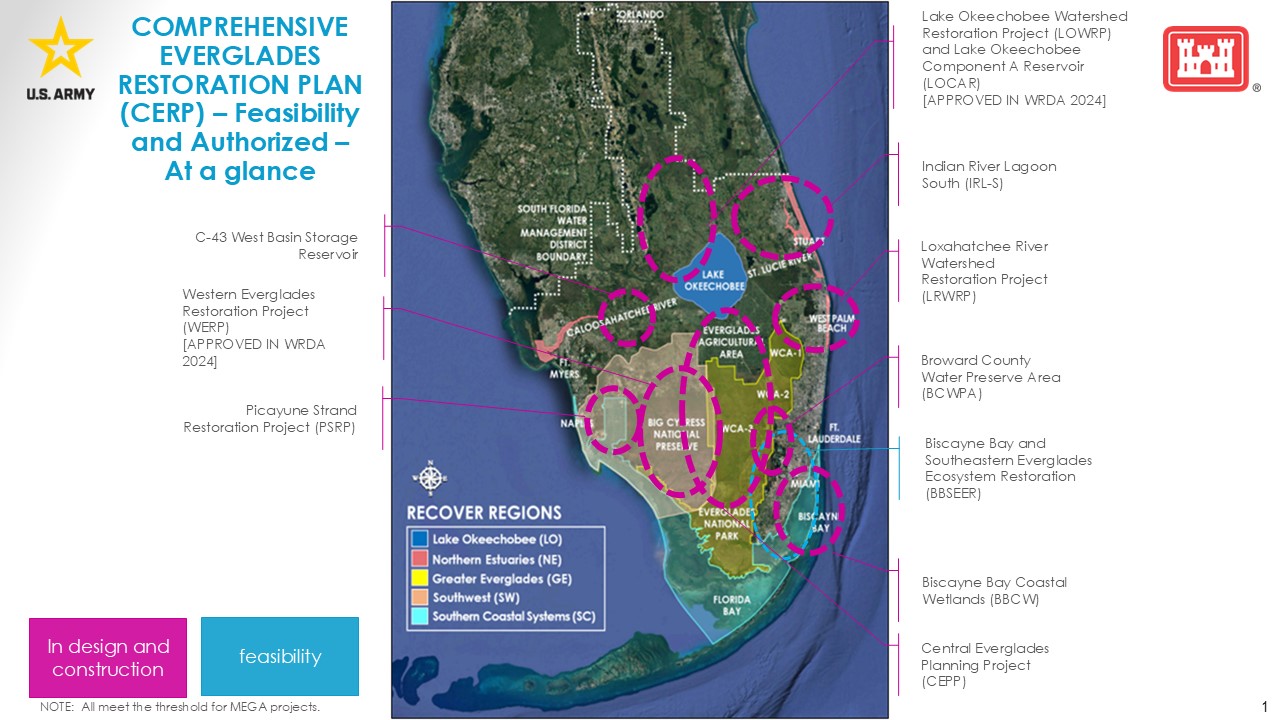May 2025
FACT SHEET
COMPREHENSIVE EVERGLADES RESTORATION PLAN
PROGRAM LEVEL ACTIVITIES - Program Management
Construction (C)
Congressional Districts: 9, 10, 11, 17, 18, 19, 20, 21, 22, 23, 24, 25, 26, 27, 28
1. DESCRIPTION
The purpose of program-level activities under the Comprehensive Everglades Restoration Plan (CERP) is to ensure effective, consistent, and transparent implementation of the plan across all projects and initiatives. These activities support the long-term success of CERP by providing centralized management, coordination, guidance, and oversight at the program level.
Authorized by Section 601(h) of the Water Resources Development Act of 2000, CERP is focused on the restoration, preservation, and protection of the south Florida ecosystem while also addressing other regional water-related needs, including water supply and flood risk management. Section 601(h) requires that the plan be implemented to achieve and sustain the benefits to the natural system and human environment described in the plan. It also directs the Secretary of the Army to issue programmatic regulations to ensure that the goals and purposes of CERP are met.
Program-level activities include:
- Managing overall program priorities and performance
- Developing guidance for product delivery teams
- Executing the Restoration, Coordination and Verification (RECOVER) program
- Preserving and managing program data
- Publishing program information electronically
- Overseeing budget and cash flow
- Preparing reports to Congress and the public
- Conducting outreach and stakeholder engagement
- Implementing and overseeing programmatic regulations
2. FUNDING
| Estimated Total Cost |
$1,070,000,000 |
| Estimated Federal Cost |
$535,000,000 |
| Allocation thru FY24 |
$135,448,300 |
| Allocation for FY25 |
$0 |
| President’s Budget FY26 |
TBD |
3. SPONSOR
South Florida Water Management District (SFWMD)
3301 Gun Club Road
West Palm Beach, Florida 33406
4. STATUS
The CERP Program-Level Activities (PLA) – Program Management project remains essential to the coordinated, transparent, and efficient implementation of the Comprehensive Everglades Restoration Plan. Program-level efforts continue to provide strategic oversight, interagency coordination, and technical support to guide restoration activities consistent with statutory requirements and long-term program goals.
Key efforts in 2025 include:
- USACE Vertical Team Coordination: Ongoing coordination with the USACE vertical team to report progress under the South Florida Ecosystem Restoration MEGA reporting requirements. The team continues to respond to data calls, evaluate program information, and support enterprise-level decision-making.
- Non-Federal Sponsor Coordination: Continued coordination with the non-federal sponsor, the South Florida Water Management District, to track and adapt to evolving program priorities, schedules, and budgets, and to implement the program efficiently and in alignment with the Integrated Delivery Schedule (IDS). Oversight of District-managed construction projects ensures consistency with the IDS and compliance with federal standards.
- Stakeholder Engagement: Continued program-level coordination with regional stakeholders to align expectations, facilitate information exchange, and promote collaboration.
- RECOVER Operations: Execution of the Restoration, Coordination, and Verification (RECOVER) program remains a core activity, including assessment of monitoring data, modeling to measure progress toward interim goals and targets, development and use of planning tools, and adaptive management recommendations—consistent with the requirements of the programmatic regulations.
- Modeling Support: Ongoing operation of the Interagency Modeling Center and use of regional modeling to support CERP implementation and RECOVER technical assessments.
- Data and Schedule Management: Regular updates to program and project cost and budget information, maintenance of schedules, and continued support for collaborative applications to ensure timely, accurate data for decision-making and public reporting.
These efforts are foundational to the long-term success of CERP, ensuring that restoration projects are implemented efficiently, transparently, and in accordance with the goals of one of the largest ecosystem restoration initiatives in the world.
